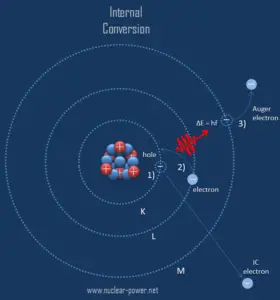
Internal conversion is an electromagnetic process, by which a nuclear excited state decays by the direct emission of one of its atomic electrons. Internal conversion competes with gamma emission, but in this case the electromagnetic multipole fields of the nucleus do not result in the emission of a gamma ray, instead, the fields interact directly with atomic electrons.
Internal Conversion Coefficient
The internal conversion coefficient (ICC), α, characterizes the competition between internal conversion and gamma ray emission. In some cases, internal conversion is favored over gamma decay. In others it may be completely negligible. The internal conversion coefficient is defined as the ratio of the number of internal conversion decays to the number of gamma decays. This ICC is defined for each electron shell (i.e., the K, L, and M shells, etc), such that the total ratio, αtotal, is the sum of the ICCs for each shell as:
αtotal = αK + αL + αM = number of IC / number of gamma decays
For example, in the decay of the excited state at 35 keV of 125Te (which is produced by the decay of 125I), 7% of the decays emit gamma ray, while 93% emit a conversion electrons. Therefore, an internal conversion coefficient of this excited state (125Te) is ICC = 93/7 = 13.3.
Using the Band-Raman Internal Conversion Coefficient calculator, the ICCs can be calculated using principles of atomic physics since it depends primarily on the density of the atomic electrons at the center of the nucleus. For increasing atomic number (Z) and decreasing gamma-ray energy, internal conversion coefficients are observed to increase.
We hope, this article, Internal Conversion Coefficient – ICC, helps you. If so, give us a like in the sidebar. Main purpose of this website is to help the public to learn some interesting and important information about radiation and dosimeters.